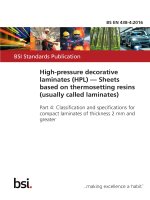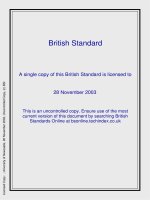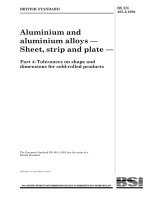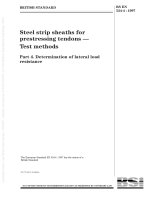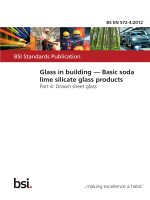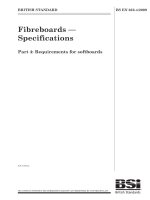Bsi bs en 10222 4 2017
Bạn đang xem bản rút gọn của tài liệu. Xem và tải ngay bản đầy đủ của tài liệu tại đây (700.59 KB, 18 trang )
BS EN 10222‑4:2017
BSI Standards Publication
Steel forgings for pressure purposes
Part 4: Weldable fine grain steels with high proo f strength
BS EN 10222‑4:2017
BRITISH STANDARD
National foreword
This British Standard is the UK implementation of EN 10222-4:2017.
It supersedes BS EN 10222-4:1999, which is withdrawn.
The UK participation in its preparation was entrusted to Technical
Committee ISE/111, Steel Castings and Forgings.
A list of organizations represented on this committee can be obtained on
request to its secretary.
This publication does not purport to include all the necessary provisions
of a contract. Users are responsible for its correct application.
ISBN 978 0 580 80527 1
ICS 77.140.30; 77.140.85
Compliance with a British Standard cannot confer immunity from
legal obligations.
This British Standard was published under the authority of the
Standards Policy and Strategy Committee on 31 May 2017.
Amendments/corrigenda issued since publication
Date
Text affected
BS EN 10222‑4:2017
EN 10222-4
EUROPEAN STANDARD
NORME EUROPÉENNE
EUROPÄISCHE NORM
April 2017
ICS 77.140.30; 77.140.85
Supersedes EN 10222-4:1998
English Version
Steel forgings for pressure purposes - Part 4: Weldable fine
grain steels with high proof strength
Pièces forgées en acier pour appareils à pression Partie 4: Aciers soudables à grains fins avec limite
d'élasticité élevée
Schmiedestücke aus Stahl für Druckbehälter - Teil 4:
Schweißgeeignete Feinkornbausstähle mit hoher
Dehngrenze
This European Standard was approved by CEN on 25 December 2016.
CEN members are bound to comply with the CEN/CENELEC Internal Regulations which stipulate the conditions for giving this
European Standard the status of a national standard without any alteration. Up-to-date lists and bibliographical references
concerning such national standards may be obtained on application to the CEN-CENELEC Management Centre or to any CEN
member.
This European Standard exists in three official versions (English, French, German). A version in any other language made by
translation under the responsibility of a CEN member into its own language and notified to the CEN-CENELEC Management
Centre has the same status as the official versions.
CEN members are the national standards bodies of Austria, Belgium, Bulgaria, Croatia, Cyprus, Czech Republic, Denmark, Estonia,
Finland, Former Yugoslav Republic of Macedonia, France, Germany, Greece, Hungary, Iceland, Ireland, Italy, Latvia, Lithuania,
Luxembourg, Malta, Netherlands, Norway, Poland, Portugal, Romania, Serbia, Slovakia, Slovenia, Spain, Sweden, Switzerland,
Turkey and United Kingdom.
EUROPEAN COMMITTEE FOR STANDARDIZATION
C O M I TÉ E URO P É E N D E N O RM ALI S ATI O N
E U RO P ÄI S C H E S KO M I T E E F Ü R N O RM U N G
CEN-CENELEC Management Centre: Avenue Marnix 17, B-1000 Brussels
© 2017 CEN
All rights of exploitation in any form and by any means reserved
worldwide for CEN national Members.
Ref. No. EN 10222-4:2017 E
BS EN 10222‑4:2017
EN 10222-4:2017 (E)
Contents
Page
European foreword ....................................................................................................................................................... 3
1
Scope .................................................................................................................................................................... 4
2
Normative references .................................................................................................................................... 4
3
Terms and definitions ................................................................................................................................... 4
4
4.1
4.2
Classification and designation .................................................................................................................... 4
Classification ..................................................................................................................................................... 4
Designation........................................................................................................................................................ 4
5
5.1
5.2
Information to be supplied by the purchaser ....................................................................................... 4
Mandatory information ................................................................................................................................ 4
Options ................................................................................................................................................................ 5
6
6.1
6.2
6.3
6.3.1
6.3.2
6.4
6.5
6.6
6.7
Requirements ................................................................................................................................................... 5
Steelmaking process and manufacture of the product...................................................................... 5
Delivery condition .......................................................................................................................................... 5
Chemical composition ................................................................................................................................... 5
Cast analysis ...................................................................................................................................................... 5
Product analysis .............................................................................................................................................. 5
Mechanical properties ................................................................................................................................... 5
Surface condition ............................................................................................................................................ 6
Internal soundness ......................................................................................................................................... 6
Resistance to hydrogen induced cracking ............................................................................................. 6
7
Inspection .......................................................................................................................................................... 6
8
Sampling ............................................................................................................................................................. 6
9
Test methods .................................................................................................................................................... 6
10
Retests ................................................................................................................................................................. 6
11
Marking ............................................................................................................................................................... 6
Annex A (informative) Significant technical changes to the version EN 10222-4:1998 .................... 13
Annex ZA (informative) Relationship between this European Standard and the Essential
Requirements of EU Directive 2014/68/EU ....................................................................................... 14
Bibliography ................................................................................................................................................................. 15
2
BS EN 10222‑4:2017
EN 10222-4:2017 (E)
European foreword
This document (EN 10222-4:2017) has been prepared by Technical Committee ECISS/TC 111 “Steel
castings and forgings”, the secretariat of which is held by AFNOR.
This European Standard shall be given the status of a national standard, either by publication of an
identical text or by endorsement, at the latest by October 2017, and conflicting national standards shall
be withdrawn at the latest by October 2017.
Attention is drawn to the possibility that some of the elements of this document may be the subject of
patent rights. CEN shall not be held responsible for identifying any or all such patent rights.
This document supersedes EN 10222-4:1998.
This document has been prepared under a mandate given to CEN by the European Commission and the
European Free Trade Association, and supports essential requirements of EU Directive 2014/68/EU.
For relationship with EU Directive 2014/68/EU, see informative Annex ZA, which is an integral part of
this document.
EN 10222 consists of the following parts under the general title “Steel forgings for pressure purposes”:
— Part 1 : General requirements for open die forgings
— Part 2: Ferritic and martensitic steels with specified elevated temperature properties
— Part 3: Nickel steels with specified low temperature properties
— Part 4: Weldable fine grain steels with high proof strength
— Part 5: Martensitic, austenitic and austenitic-ferritic stainless steels.
Annex A provides details about significant technical changes to EN 10222-4:1998.
According to the CEN-CENELEC Internal Regulations, the national standards organisations of the
following countries are bound to implement this European Standard: Austria, Belgium, Bulgaria,
Croatia, Cyprus, Czech Republic, Denmark, Estonia, Finland, Former Yugoslav Republic of Macedonia,
France, Germany, Greece, Hungary, Iceland, Ireland, Italy, Latvia, Lithuania, Luxembourg, Malta,
Netherlands, Norway, Poland, Portugal, Romania, Serbia, Slovakia, Slovenia, Spain, Sweden, Switzerland,
Turkey and the United Kingdom.
3
BS EN 10222‑4:2017
EN 10222-4:2017 (E)
1 Scope
This European Standard specifies the technical delivery conditions for forgings for pressure purposes,
made of weldable fine grain steels with high proof strength.
NOTE
Once this standard is published in the EU Official Journal (OJEU) under Directive 2014/68/EU,
presumption of conformity to the Essential Safety Requirements (ESRs) of Directive 2014/68/EU is limited to
technical data of materials in this standard and does not presume adequacy of the material to a specific item of
equipment. Consequently, the assessment of the technical data stated in this material standard against the design
requirements of this specific item of equipment to verify that the ESRs of Directive 2014/68/EU are satisfied,
needs to be done. The series EN 10222–1 to EN 10222–5 is structured so that the data related to different
materials is in the part allocated for that material. The presumption of conformity to the Essential Safety
Requirements of Directive 2014/68/EU depends on both the text in part 1 and the data in part 2, 3, 4 or 5.
General information on technical delivery conditions is given in EN 10021.
2 Normative references
The following documents, in whole or in part, are normatively referenced in this document and are
indispensable for its application. For dated references, only the edition cited applies. For undated
references, the latest edition of the referenced document (including any amendments) applies.
EN 10222-1:2017, Steel forgings for pressure purposes — Part 1 : General requirements
3 Terms and definitions
For the purpose of this document, the terms and definitions given in EN 10222-1:2017 apply.
4 Classification and designation
4.1 Classification
In accordance with the classification system in EN 10020, the steel grades specified in this document
are non-alloy quality steels (P285NH, P285QH, P355NH, P355QH1, P355NL1), non-alloy special steel
(P355NL2) and alloy special steels (P355QL1, P355QL2, P420NH, P420QH, P460QH, P460QL1,
P460QL2).
4.2 Designation
See EN 10222-1:2017.
5 Information to be supplied by the purchaser
5.1 Mandatory information
Shall be in accordance with EN 10222-1:2017.
4
BS EN 10222‑4:2017
EN 10222-4:2017 (E)
5.2 Options
A number of options are specified in this document and listed below. Additionally, the relevant options
of EN 10222-1:2017 apply.
1) test temperature for the tensile test at elevated temperature, if applicable (see 6.4);
2) carbon equivalent for non-alloy steels (see Table 2, footnote b);
3) higher Al content (see Table 2, footnote c);
4) higher sulphur content (see Table 2, footnote f);
5) mechanical properties for grades type P460 in normalized condition (see Table 4 footnote f and
Table 6, footnote a);
6) different test temperature for the min. impact energy (see Table 5, footnote c);
7) minimum impact energy values (see Table 5 footnote d);
8) test to evaluate the resistance to hydrogen induced cracking (see 6.7).
6 Requirements
6.1 Steelmaking process and manufacture of the product
Shall be in accordance with EN 10222-1:2017.
6.2 Delivery condition
The products shall be delivered in the heat treatment condition specified in Table 1.
6.3 Chemical composition
6.3.1 Cast analysis
The chemical composition (cast analysis), determined in accordance with EN 10222-1:2017 shall
conform to the requirements of Table 2.
6.3.2 Product analysis
The product analysis shall not deviate from the specified cast analysis (see Table 2) by more than the
values specified in Table 3.
6.4 Mechanical properties
When heat treated in accordance with Table 1, the mechanical properties shall conform to the
requirements of Tables 4 and 5.
Elevated temperature proof strength (RP0,2 ) values shall conform to the requirements of Table 6.
If verification of specified proof strength at elevated temperature is requested (see option in
EN 10222-1:2017), the testing temperature should be agreed at the time of enquiry and order.
Otherwise, the test shall be carried out at 300 °C.
5
BS EN 10222‑4:2017
EN 10222-4:2017 (E)
6.5 Surface condition
See EN 10222-1:2017.
6.6 Internal soundness
See EN 10222-1:2017.
6.7 Resistance to hydrogen induced cracking
Steels covered by this standard may be susceptible to cracking when exposed to corrosive H 2 S
containing environments, usually referred to as „sour service“.
A test to evaluate the resistance to hydrogen induced cracking in accordance with EN 10229 may be
agreed at the time of enquiry and order.
7 Inspection
See EN 10222-1:2017.
8 Sampling
See EN 10222-1:2017.
9 Test methods
See EN 10222-1:2017.
10 Retests
See EN 10222-1:2017.
11 Marking
See EN 10222-1:2017.
6
BS EN 10222‑4:2017
EN 10222-4:2017 (E)
Table 1 — Heat treatment
Steel grade
Austenitizing
or normalizing
Heat
treatmenta Temperature
Cooling inb
°C
Tempering
Steel
name
Steel number
P285NH
1.0477
+N
880 to 960
a
–
P285QH
1.0478
+QT
860 to 940
o, w
600 to 700
P355NH
1.0565
+N
880 to 960
a
–
P355NL1 c
1.0566
+N
880 to 960
a
–
P355NL2 c
1.1106
+N
880 to 960
a
–
P355QH1
1.0571
+QT
860 to 940
o, w
600 to 700
P355QL1
1.8868
+QT
860 to 940
o, w
600 to 700
P355QL2
1.8869
+QT
860 to 940
o, w
600 to 700
P420NH c
1.8932
+N
880 to 960
a
–
P420QH
1.8936
+QT
860 to 940
o, w
600 to 700
P460QH
1.8871
+QT
860 to 940
o, w
600 to 700
P460QL1
1.8872
+QT
860 to 940
o, w
600 to 700
P460 QL2
1.8864
+QT
860 to 940
o, w
600 to 700
a
+ N = normalized, +QT = quenched and tempered.
b
a = air, o = oil, w = water or water based medium.
c
Limited to teq < 40 mm (see prEN 10222–1:2015, Table A.1)
Temperature
°C
7
Table 2 — Chemical composition (cast analysis)
Steel designation
Steel
name
Steel number
P285NH
1.0477
P285QH
1.0478
P355NH
1.0565
P355NL1
1.0566
P355NL2
1.1106
P355QH1
1.0571
P355QL1
1.8868
P355QL2
1.8869
P420NH
1.8932
P420QH
1.8936
P460QH
1.8871
P460QL1
1.8872
P460QL2
1.8834
% by mass a
C
max.
Si
max.
Mn
P
max.
Sf
max.
Al total
N
max.
Cr
max.
Cu
max.
Mo
max.
Nb
max.
Ni
max.
V
max.
Nb +
V
max.
0,18
0,40
0,80
to
1,50
0,025
0,010
≥ 0,020 c
0,020
0,30
0,20
0,08
0,03
0,30
0,05
0,05
0,50
1,10
to
1,70
≥ 0,020 c
0,015
0,30 d
0,30 d
0,08 d
0,05
0,50
0,10
0,12
0,18
0,18
0,40
0,90
to
1,50
0,20
0,60
1,10
to
1,70
0,50
1,10
to
1,70
0,18
0,025
0,020
Carbon
equivalent
value b
% by mass
0,41
0,010
0,008
0,025
0,010
0,020
0,008
0,025
0,010
0,020
0,008
0,025
0,010
0,020
0,008
0,47
≥ 0,020 c
0,015
0,30
0,30
0,25
0,05 e
0,50
≥ 0,020 c
0,020
0,30
0,20
0,10
0,05
1,00
≥ 0,020 c
0,015
0,50
0,30
0,50
0,05
1,00
0,10 e
0,12
0,20
0,22
0,15
-e
0,15
-e
0,51
0,51
a Elements not listed in this Table shall not be intentionally added to the steel without the approval of the purchase except for finishing the cast. All appropriate measures shall
be taken to prevent the addition from scrap or other materials used in steelmaking of these elements which may adversely affect the mechanical properties and usability.
b If agreed at the time of enquiry and order (see also EN 10222–1:2017, 6.4.1.5).
c
d
e
A maximum value of 0,050 should be agreed at time of enquiry and order. If only aluminium is used for nitrogen binding, a ratio Al/N ≥ 2 shall apply.
The sum of the percentages by mass of the three elements chromium, copper and molybdenum shall not exceed 0,45 %.
Ti and Zr may also be added: Ti ≤ 0,03 %, Zr ≤ 0,05 %The percentage of grain refining elements shall be at least 0,15 %.
f A maximum sulphur content up to 0,015 % may be agreed at time of enquiry and order. In this case the mechanical properties stated in the according tables are also valid and
shall be fulfilled.
8
BS EN 10222‑4:2017
EN 10222-4:2017 (E)
BS EN 10222‑4:2017
EN 10222-4:2017 (E)
Table 3 — Permissible deviations of the product analysis above the maximum or below the
minimum limits of the requirement of cast analysis
Specified range
Permissible deviations a
%
%
C
≤ 0,20
+0,02
Si
≤ 0,60
+ 0,05
≤ 1,00
+0,05
> 1,00 to ≤ 1,70
±0,10
P
≤ 0,025
+ 0,005
S
≤ 0,010
+ 0,003
Al
≥ 0,020 to ≤ 0,050
±0,005
N
< 0,025
+ 0,002
Cr
≤ 0,50
+ 0,05
Mo
≤ 0,10
+ 0,03
Cu
≤ 0,20
+ 0,05
Nb
≤ 0,05
+ 0,01
Ni
≤ 1,00
+ 0,05
Ti
≤ 0,03
+ 0,01
V
≤ 0,20
+ 0,01
Nb +V
≤ 0,22
+0,02
Element
Mn
a If several product analyses are carried out for one cast and if, in this case, values for individual elements are
established which fall outside the permitted range for the chemical composition, then it is only permissible that the
values either exceed the maximum permitted value or fall short of the minimum permitted value. It is not acceptable
for both to apply for one cast.
9
BS EN 10222‑4:2017
EN 10222-4:2017 (E)
Table 4 — Mechanical properties at room temperature
Steel grade
Steel
name
Steel
number
Heat
treatmenta
Thickness of
the
ruling
section
tRb
mm
tR ≤
P285NH
P285QH e
1.0477
1.0478
P355NH
1.0565
P355NL1
1.0566
P355NL2
+N
+QT
16
Yield
strength
ReH c
Tensile
strength
MPa
min.
MPa
275
35 < tR ≤ 70
260
70 < tR ≤ 100
245
100 < tR ≤ 250
225
250 < tR ≤ 400
205
16
345
1.1106
35 < tR ≤ 70
330
P355QH1 e
1.0571
70 < tR ≤ 100
315
P355QL1 e
1.8872
100 < tR ≤ 250
295
P355QL2 e
1.8864
250 < tR ≤ 400
275
+QT
tR ≤
P420NH
P420QH e
1.8932
1.8936
P460QH e,f
1.8871
P460QL1 e,f
1.8872
P460QL2 e,f
1.8864
+N
+QT
410
35 < tR ≤ 70
390
70 < tR ≤ 100
375
100 < tR ≤ 250
345
250 < tR ≤ 400
325
100
tr, t
390 to 510
24
23
370 to 510
22
21
490 to 630
23
21
470 to 630
21
19
530 to 680
20
19
510 to 670
18
17
520 to 710
18
16
420
16 < tR ≤ 35
tR ≤
+QT
16
l
355
16 < tR ≤ 35
+N
%
min
285
16 < tR ≤ 35
tR ≤
Rm
Elongation
after fracture
Ad
420
100 < tR ≤ 250
400
250 < tR ≤ 400
380
a
+A annealed; +N normalized; +QT quenched and tempered; +NT normalized and tempered.
b The thickness ranges given in this column apply for the as heat treated thickness of forgings with the ruling section. This is
characterized by rectangular shape, a width to thickness ratio ≥ 2 and a length to thickness ratio ≥ 4. For forgings with other
sections the equivalent thickness shall be determined according to EN 10222–1:2017, Annex A or be agreed at the time of
enquiry and order.
c Until the yield point criteria are harmonized in the various national codes, determination of ReH may be replaced by
determination of Rp0,2. In this case, Rp0,2 values are 10 MPa lower for ReH values up to 355 MPa and 15 MPa lower for ReH
values greater than 355 MPa.
d l = longitudinal, t = tangential, tr = transverse.
e
For thickness less than 70 mm the tensile strength values for QT grades are the same as for normalized grades
f For the three grades P460QH, P460QL1, and P460QL2 in normalized conditions the values for the mechanical properties
should be agreed at the time of enquiry and order.
10
BS EN 10222‑4:2017
EN 10222-4:2017 (E)
Table 5 — Minimum impact energy
Steel
designation
Heat
Treatment
condition a,b
Thickness
of the
ruling
section
tR
mm
Impact energy KV2 in Jc
min
at a test temperature in °C of:
longitudinal
Transversal and tangential
+20
0
-20
-40
-50
+20
0
-20
-40
-50
P285NH
P355NH
+N
≤ 70
55
47
40
27 d
-
40
34
27 d
-
-
+QT
≤ 400
63
55
47
34
-
40
34
27 d
-
-
+N
≤ 70
55
47
40
27 d
-
47
40
34
27 d
-
+QT
≤ 400
63
55
47
34
-
47
40
34
27 d
-
+N
≤ 70
55
47
40
30
27 d
47
40
34
30
27 d
+QT
≤ 400
63
55
47
34
27 d
47
40
34
30
27 d
P420NH
P285QH
P355QH1
P420QH
P460QH
P355NL1
P355QL1
P420QL1
P460QL1
P355NL2
P355QL2
P460QL2
a
+ N = normalized; +QT = quenched and tempered.
b
For temperatures and cooling conditions, see Table 1.
c Where minimum impact energy values are specified for several temperatures, verification of the impact energy,
unless otherwise agreed, shall be carried out at the temperature for which the value of 27 J is specified. Where the
minimum impact energy value specified at the lowest temperature is higher than 27 J, this higher value shall be verified
d
A minimum impact energy value of 40 J may be agreed at the time of enquiry and order.
11
BS EN 10222‑4:2017
EN 10222-4:2017 (E)
Table 6 — Minimum 0,2 % proof strength Rp0,2 values at elevated temperatures
Steel grade
Steel
name
Steel
number
Thickness of the ruling
section tR
50
100
150
200
250
300
350
400
276
259
240
221
202
166
153
144
16 < tR ≤ 35
266
250
232
213
195
160
148
139
35 < tR ≤ 70
251
237
219
201
184
151
140
131
70 < tR ≤ 100
237
223
206
190
174
143
132
124
100 < tR ≤ 250
218
205
190
174
160
131
121
114
250 < tR ≤ 400
198
187
173
159
145
119
110
104
343
323
299
275
252
232
214
202
16 < tR ≤ 35
334
314
291
267
245
225
208
196
35 < tR ≤ 70
319
300
278
256
234
215
199
187
70 < tR ≤ 100
305
287
265
244
224
206
190
179
100 < tR ≤ 250
285
268
249
228
209
192
178
167
250 < tR ≤ 400
266
250
232
213
195
179
166
156
406
382
354
325
298
274
254
238
16 < tR ≤ 35
396
373
346
318
291
267
248
233
35 < tR ≤ 70
377
355
329
302
277
254
236
221
70 < tR ≤ 100
363
341
316
290
266
245
227
213
100 < tR ≤ 250
334
314
291
267
245
225
208
196
250 < tR ≤ 400
314
296
274
252
231
212
196
185
402
392
363
343
314
294
265
235
100 < tR ≤ 250
382
363
333
314
284
265
235
206
250 < tR ≤ 400
373
353
324
304
275
255
226
196
tR ≤
P285NH
P285QH
1.0477
1.0478
tR ≤
P355NH
P355QH1
1.0565
1.0571
tR ≤
P420NH
P420QH
1.8932
1.8936
tR ≤
P460QH a
1.8871
Rp0,2, min. in MPa at a Temperature in °C of
16
16
16
100
a For the three grades P460 in normalized conditions the values for the mechanical properties should be agreed at the time
of enquiry and order.
12
BS EN 10222‑4:2017
EN 10222-4:2017 (E)
Annex A
(informative)
Significant technical changes to the version EN 10222-4:1998
Significant technical changes to the previous version EN 10222-4:1998 are listed below:
1) Updating of the normative references;
2) Generally alignment of the requirements with EN 10222 − 1;
3) Updating of the optional information’s in chapter 5.2;
4) Table 1 containing values and statements on the heat treatment of the steels updated;
5) New Table 4 containing values for the mechanical properties at room temperature;
6) New steel grades added: P355NL1 and NL2; P355QL1 and QL2; P460QL1 and QL2;
7) Updating of the values for the chemical composition and mechanical properties for the steel grades
covered by this part of the EN 10222 series;
8) New sub Clause 6.7 “Resistance to hydrogen induced cracking” inserted in the standard;
9) Updating of Annex ZA in relationship with EU Directive 2014/68/EU.
13
BS EN 10222‑4:2017
EN 10222-4:2017 (E)
Annex ZA
(informative)
Relationship between this European Standard and the Essential
Requirements of EU Directive 2014/68/EU
This European Standard has been prepared under a Commission’s standardization request M/071 to
provide one voluntary means of conforming to Essential Requirements of Directive 2014/68/EU.
Once this standard is cited in the Official Journal of the European Union under that Directive,
compliance with the normative clauses of this standard given in Table ZA.1 confers, within the limits of
the scope of this standard, a presumption of conformity with the corresponding Essential Requirements
of Directive 2014/68/EU, and associated EFTA regulations.
Table ZA.1 — Correspondence between this European Standard and Annex I of Directive
2014/68/EU
Requirements of Directive
2014/68/EU
Clause(s)/subclause(s) of
this EN
Remarks/Notes
4.1a
6.4
Appropriate material
properties
4.1d
6.2, 6.5, 6.6
Suitable for the processing
procedures
4.3
Clause 7 (EN 10222–1:2017,
7.1)
Inspection documentation
WARNING 1 — Presumption of conformity stays valid only as long as a reference to this European
Standard is maintained in the list published in the Official Journal of the European Union. Users of this
standard should consult frequently the latest list published in the Official Journal of the European
Union.
WARNING 2 — Other Union legislation may be applicable to the product(s) falling within the scope of
this standard.
14
BS EN 10222‑4:2017
EN 10222-4:2017 (E)
Bibliography
[1]
EN 10021:2006, General technical delivery conditions for steel products
[2]
EN 10229, Evaluation of resistance of steel products to hydrogen induced cracking (HIC)
15
NO COPYING WITHOUT BSI PERMISSION EXCEPT AS PERMITTED BY COPYRIGHT LAW
British Standards Institution (BSI)
BSI is the national body responsible for preparing British Standards and other
standards-related publications, information and services.
BSI is incorporated by Royal Charter. British Standards and other standardization
products are published by BSI Standards Limited.
About us
Reproducing extracts
We bring together business, industry, government, consumers, innovators
and others to shape their combined experience and expertise into standards
-based solutions.
For permission to reproduce content from BSI publications contact the BSI
Copyright & Licensing team.
The knowledge embodied in our standards has been carefully assembled in
a dependable format and ref ned through our open consultation process.
Organizations of all sizes and across all sectors choose standards to help
them achieve their goals.
Information on standards
We can provide you with the knowledge that your organization needs
to succeed. Find out more about British Standards by visiting our website at
bsigroup.com/standards or contacting our Customer Services team or
Knowledge Centre.
Buying standards
You can buy and download PDF versions of BSI publications, including British
and adopted European and international standards, through our website at
bsigroup.com/shop, where hard copies can also be purchased.
If you need international and foreign standards from other Standards Development
Organizations, hard copies can be ordered from our Customer Services team.
Copyright in BSI publications
All the content in BSI publications, including British Standards, is the property
of and copyrighted by BSI or some person or entity that owns copyright in the
information used (such as the international standardization bodies) and has
formally licensed such information to BSI for commercial publication and use.
Save for the provisions below, you may not transfer, share or disseminate any
portion of the standard to any other person. You may not adapt, distribute,
commercially exploit, or publicly display the standard or any portion thereof in any
manner whatsoever without BSI’s prior written consent.
Storing and using standards
Standards purchased in soft copy format:
• A British Standard purchased in soft copy format is licensed to a sole named
user for personal or internal company use only.
• The standard may be stored on more than 1 device provided that it is accessible
by the sole named user only and that only 1 copy is accessed at any one time.
• A single paper copy may be printed for personal or internal company use only.
• Standards purchased in hard copy format:
• A British Standard purchased in hard copy format is for personal or internal
company use only.
• It may not be further reproduced – in any format – to create an additional copy.
This includes scanning of the document.
If you need more than 1 copy of the document, or if you wish to share the
document on an internal network, you can save money by choosing a subscription
product (see ‘Subscriptions’).
Subscriptions
Our range of subscription services are designed to make using standards
easier for you. For further information on our subscription products go to
bsigroup.com/subscriptions.
With British Standards Online (BSOL) you’ll have instant access to over 55,000
British and adopted European and international standards from your desktop.
It’s available 24/7 and is refreshed daily so you’ll always be up to date.
You can keep in touch with standards developments and receive substantial
discounts on the purchase price of standards, both in single copy and subscription
format, by becoming a BSI Subscribing Member.
PLUS is an updating service exclusive to BSI Subscribing Members. You will
automatically receive the latest hard copy of your standards when they’re
revised or replaced.
To f nd out more about becoming a BSI Subscribing Member and the benef ts
of membership, please visit bsigroup.com/shop.
With a Multi-User Network Licence (MUNL) you are able to host standards
publications on your intranet. Licences can cover as few or as many users as you
wish. With updates supplied as soon as they’re available, you can be sure your
documentation is current. For further information, email
Revisions
Our British Standards and other publications are updated by amendment or revision.
We continually improve the quality of our products and services to benef t your
business. If you f nd an inaccuracy or ambiguity within a British Standard or other
BSI publication please inform the Knowledge Centre.
Useful Contacts
Customer Services
Tel: +44 345 086 9001
Email (orders): orders@bsigroup. com
Email (enquiries): cservices@bsigroup. com
Subscriptions
Tel: +44 345 086 9001
Email: subscriptions@bsigroup. com
Knowledge Centre
Tel: +44 20 8996 7004
Email: knowledgecentre@bsigroup. com
Copyright & Licensing
Tel: +44 20 8996 7070
Email: copyright@bsigroup. com
BSI Group Headquarters
389 Chiswick High Road London W4 4AL UK
This page deliberately left blank

